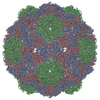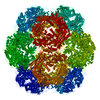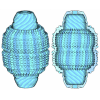+ データを開く
データを開く
- 基本情報
基本情報
| 登録情報 |  | |||||||||
|---|---|---|---|---|---|---|---|---|---|---|
| タイトル | Cargo-loaded Myxococcus xanthus EncA encapsulin engineered pore mutant with T=3 icosahedral symmetry | |||||||||
 マップデータ マップデータ | ||||||||||
 試料 試料 |
| |||||||||
 キーワード キーワード | encapsulin / nanocompartment / pore mutant / VIRUS LIKE PARTICLE | |||||||||
| 機能・相同性 |  機能・相同性情報 機能・相同性情報encapsulin nanocompartment / iron ion transport / intracellular iron ion homeostasis / metal ion binding 類似検索 - 分子機能 | |||||||||
| 生物種 |  Myxococcus xanthus DK 1622 (バクテリア) Myxococcus xanthus DK 1622 (バクテリア) | |||||||||
| 手法 | 単粒子再構成法 / クライオ電子顕微鏡法 / 解像度: 3.14 Å | |||||||||
 データ登録者 データ登録者 | Andreas MP / Kwon S / Giessen TW | |||||||||
| 資金援助 |  米国, 1件 米国, 1件
| |||||||||
 引用 引用 |  ジャーナル: ACS Nano / 年: 2024 ジャーナル: ACS Nano / 年: 2024タイトル: Pore Engineering as a General Strategy to Improve Protein-Based Enzyme Nanoreactor Performance. 著者: Seokmu Kwon / Michael P Andreas / Tobias W Giessen /  要旨: Enzyme nanoreactors are nanoscale compartments consisting of encapsulated enzymes and a selectively permeable barrier. Sequestration and colocalization of enzymes can increase catalytic activity, ...Enzyme nanoreactors are nanoscale compartments consisting of encapsulated enzymes and a selectively permeable barrier. Sequestration and colocalization of enzymes can increase catalytic activity, stability, and longevity, highly desirable features for many biotechnological and biomedical applications of enzyme catalysts. One promising strategy to construct enzyme nanoreactors is to repurpose protein nanocages found in nature. However, protein-based enzyme nanoreactors often exhibit decreased catalytic activity, partially caused by a mismatch of protein shell selectivity and the substrate requirements of encapsulated enzymes. No broadly applicable and modular protein-based nanoreactor platform is currently available. Here, we introduce a pore-engineered universal enzyme nanoreactor platform based on encapsulins-microbial self-assembling protein nanocompartments with programmable and selective enzyme packaging capabilities. We structurally characterize our protein shell designs via cryo-electron microscopy and highlight their polymorphic nature. Through fluorescence polarization assays, we show their improved molecular flux behavior and highlight their expanded substrate range via a number of proof-of-concept enzyme nanoreactor designs. This work lays the foundation for utilizing our encapsulin-based nanoreactor platform for diverse future biotechnological and biomedical applications. | |||||||||
| 履歴 |
|
- 構造の表示
構造の表示
| 添付画像 |
|---|
- ダウンロードとリンク
ダウンロードとリンク
-EMDBアーカイブ
| マップデータ |  emd_44388.map.gz emd_44388.map.gz | 306.7 MB |  EMDBマップデータ形式 EMDBマップデータ形式 | |
|---|---|---|---|---|
| ヘッダ (付随情報) |  emd-44388-v30.xml emd-44388-v30.xml emd-44388.xml emd-44388.xml | 20.7 KB 20.7 KB | 表示 表示 |  EMDBヘッダ EMDBヘッダ |
| FSC (解像度算出) |  emd_44388_fsc.xml emd_44388_fsc.xml | 14.5 KB | 表示 |  FSCデータファイル FSCデータファイル |
| 画像 |  emd_44388.png emd_44388.png | 176.8 KB | ||
| Filedesc metadata |  emd-44388.cif.gz emd-44388.cif.gz | 6.7 KB | ||
| その他 |  emd_44388_half_map_1.map.gz emd_44388_half_map_1.map.gz emd_44388_half_map_2.map.gz emd_44388_half_map_2.map.gz | 301.1 MB 301.1 MB | ||
| アーカイブディレクトリ |  http://ftp.pdbj.org/pub/emdb/structures/EMD-44388 http://ftp.pdbj.org/pub/emdb/structures/EMD-44388 ftp://ftp.pdbj.org/pub/emdb/structures/EMD-44388 ftp://ftp.pdbj.org/pub/emdb/structures/EMD-44388 | HTTPS FTP |
-検証レポート
| 文書・要旨 |  emd_44388_validation.pdf.gz emd_44388_validation.pdf.gz | 1.3 MB | 表示 |  EMDB検証レポート EMDB検証レポート |
|---|---|---|---|---|
| 文書・詳細版 |  emd_44388_full_validation.pdf.gz emd_44388_full_validation.pdf.gz | 1.3 MB | 表示 | |
| XML形式データ |  emd_44388_validation.xml.gz emd_44388_validation.xml.gz | 23.2 KB | 表示 | |
| CIF形式データ |  emd_44388_validation.cif.gz emd_44388_validation.cif.gz | 30.5 KB | 表示 | |
| アーカイブディレクトリ |  https://ftp.pdbj.org/pub/emdb/validation_reports/EMD-44388 https://ftp.pdbj.org/pub/emdb/validation_reports/EMD-44388 ftp://ftp.pdbj.org/pub/emdb/validation_reports/EMD-44388 ftp://ftp.pdbj.org/pub/emdb/validation_reports/EMD-44388 | HTTPS FTP |
-関連構造データ
- リンク
リンク
| EMDBのページ |  EMDB (EBI/PDBe) / EMDB (EBI/PDBe) /  EMDataResource EMDataResource |
|---|---|
| 「今月の分子」の関連する項目 |
- マップ
マップ
| ファイル |  ダウンロード / ファイル: emd_44388.map.gz / 形式: CCP4 / 大きさ: 325 MB / タイプ: IMAGE STORED AS FLOATING POINT NUMBER (4 BYTES) ダウンロード / ファイル: emd_44388.map.gz / 形式: CCP4 / 大きさ: 325 MB / タイプ: IMAGE STORED AS FLOATING POINT NUMBER (4 BYTES) | ||||||||||||||||||||||||||||||||||||
|---|---|---|---|---|---|---|---|---|---|---|---|---|---|---|---|---|---|---|---|---|---|---|---|---|---|---|---|---|---|---|---|---|---|---|---|---|---|
| 投影像・断面図 | 画像のコントロール
画像は Spider により作成 | ||||||||||||||||||||||||||||||||||||
| ボクセルのサイズ | X=Y=Z: 1.15818 Å | ||||||||||||||||||||||||||||||||||||
| 密度 |
| ||||||||||||||||||||||||||||||||||||
| 対称性 | 空間群: 1 | ||||||||||||||||||||||||||||||||||||
| 詳細 | EMDB XML:
|
-添付データ
- 試料の構成要素
試料の構成要素
-全体 : Cargo-loaded Myxococcus xanthus EncA encapsulin engineered pore m...
| 全体 | 名称: Cargo-loaded Myxococcus xanthus EncA encapsulin engineered pore mutant with T=3 icosahedral symmetry |
|---|---|
| 要素 |
|
-超分子 #1: Cargo-loaded Myxococcus xanthus EncA encapsulin engineered pore m...
| 超分子 | 名称: Cargo-loaded Myxococcus xanthus EncA encapsulin engineered pore mutant with T=3 icosahedral symmetry タイプ: complex / ID: 1 / 親要素: 0 / 含まれる分子: all |
|---|---|
| 由来(天然) | 生物種:  Myxococcus xanthus DK 1622 (バクテリア) Myxococcus xanthus DK 1622 (バクテリア) |
| 分子量 | 理論値: 5.7 MDa |
-超分子 #2: Myxococcus xanthus EncA encapsulin engineered pore mutant with T=...
| 超分子 | 名称: Myxococcus xanthus EncA encapsulin engineered pore mutant with T=3 icosahedral symmetry タイプ: complex / ID: 2 / 親要素: 1 / 含まれる分子: #1 |
|---|---|
| 由来(天然) | 生物種:  Myxococcus xanthus DK 1622 (バクテリア) Myxococcus xanthus DK 1622 (バクテリア) |
-超分子 #3: SNAP-tag-targeting peptide cargo protein
| 超分子 | 名称: SNAP-tag-targeting peptide cargo protein / タイプ: complex / ID: 3 / 親要素: 2 / 含まれる分子: #2 |
|---|---|
| 由来(天然) | 生物種:  Myxococcus xanthus DK 1622 (バクテリア) Myxococcus xanthus DK 1622 (バクテリア) |
-分子 #1: Type 1 encapsulin shell protein EncA
| 分子 | 名称: Type 1 encapsulin shell protein EncA / タイプ: protein_or_peptide / ID: 1 / コピー数: 3 / 光学異性体: LEVO |
|---|---|
| 由来(天然) | 生物種:  Myxococcus xanthus DK 1622 (バクテリア) Myxococcus xanthus DK 1622 (バクテリア) |
| 分子量 | 理論値: 30.901014 KDa |
| 組換発現 | 生物種:  |
| 配列 | 文字列: MPDFLGHAEN PLREEEWARL NETVIQVARR SLVGRRILDI YGPLGAGVQT VPYDEFQGVS PGAVDIVGEQ ETAMVFTDAR KFKTIPIIY KDFLLHWRDI EAARTHNMPL DVSAAAGAAA LCAQQEDELI FYGDARLGYE GLMTANGRLT VPLGDWTSPG G GFQAIVEA ...文字列: MPDFLGHAEN PLREEEWARL NETVIQVARR SLVGRRILDI YGPLGAGVQT VPYDEFQGVS PGAVDIVGEQ ETAMVFTDAR KFKTIPIIY KDFLLHWRDI EAARTHNMPL DVSAAAGAAA LCAQQEDELI FYGDARLGYE GLMTANGRLT VPLGDWTSPG G GFQAIVEA TRKLNEQGHF GPYAVVLSPR LYSQLHRGGE IETIRQLASD GVYQSNRLRG ESGVVVSTGR ENMDLAVSMD MV AAYLGAS RMNHPFRVLE ALLLRIKHPD AICTLEGAGA TERR UniProtKB: Type 1 encapsulin shell protein EncA |
-分子 #2: Encapsulin nanocompartment cargo protein EncC
| 分子 | 名称: Encapsulin nanocompartment cargo protein EncC / タイプ: protein_or_peptide / ID: 2 / コピー数: 3 / 光学異性体: LEVO |
|---|---|
| 由来(天然) | 生物種:  Myxococcus xanthus DK 1622 (バクテリア) Myxococcus xanthus DK 1622 (バクテリア) |
| 分子量 | 理論値: 1.415685 KDa |
| 組換発現 | 生物種:  |
| 配列 | 文字列: PEKRLTVGSL RR UniProtKB: Encapsulin nanocompartment cargo protein EncC |
-実験情報
-構造解析
| 手法 | クライオ電子顕微鏡法 |
|---|---|
 解析 解析 | 単粒子再構成法 |
| 試料の集合状態 | particle |
- 試料調製
試料調製
| 濃度 | 4.1 mg/mL | |||||||||
|---|---|---|---|---|---|---|---|---|---|---|
| 緩衝液 | pH: 7.5 構成要素:
詳細: 150 mM NaCl, 20 mM Tris pH 7.5 | |||||||||
| グリッド | モデル: Quantifoil R1.2/1.3 / 材質: COPPER / メッシュ: 200 / 支持フィルム - 材質: CARBON / 支持フィルム - トポロジー: HOLEY / 前処理 - タイプ: GLOW DISCHARGE / 前処理 - 時間: 60 sec. / 前処理 - 雰囲気: AIR 詳細: The grid was glow discharged at 5 mA for 60 seconds under vacuum. | |||||||||
| 凍結 | 凍結剤: ETHANE / チャンバー内湿度: 100 % / チャンバー内温度: 295 K / 装置: FEI VITROBOT MARK IV 詳細: Blot force: 20 Blot time: 4 seconds Wait time: 0 seconds. |
- 電子顕微鏡法
電子顕微鏡法
| 顕微鏡 | FEI TECNAI ARCTICA |
|---|---|
| 撮影 | フィルム・検出器のモデル: GATAN K2 SUMMIT (4k x 4k) 検出モード: COUNTING / デジタル化 - サイズ - 横: 3710 pixel / デジタル化 - サイズ - 縦: 3838 pixel / 撮影したグリッド数: 1 / 実像数: 706 / 平均露光時間: 6.0 sec. / 平均電子線量: 39.18 e/Å2 |
| 電子線 | 加速電圧: 200 kV / 電子線源:  FIELD EMISSION GUN FIELD EMISSION GUN |
| 電子光学系 | 照射モード: FLOOD BEAM / 撮影モード: BRIGHT FIELD / 最大 デフォーカス(公称値): 1.8 µm / 最小 デフォーカス(公称値): 1.0 µm / 倍率(公称値): 45000 |
| 実験機器 |  モデル: Talos Arctica / 画像提供: FEI Company |
+ 画像解析
画像解析
-原子モデル構築 1
| 初期モデル | PDB ID: Chain - Source name: PDB / Chain - Initial model type: experimental model |
|---|---|
| 詳細 | ChimeraX v1.2.5 was first used to place the starting model (PDB: 7S4Q) in the cryo-EM map by using the fit in map command. The model was then manually refined using Coot v 0.9.8.1, followed by iterative real-space refinements in Phenix v1.20.1-4487-000. BioMT operators were identified from the cryo-EM map using map_symmetry command in Phenix then applied to the model using the apply_ncs command to assemble the complete shell. Real-space refinement was repeated in Phenix with NCS constraints applied. The BioMT operators were then identified using find_ncs command in Phenix and applied to the header of a protomer of the NCS-refined model. |
| 精密化 | 空間: REAL / プロトコル: FLEXIBLE FIT / 温度因子: 93.1 当てはまり具合の基準: cross-correlation coefficient |
| 得られたモデル |  PDB-9b9q: |
 ムービー
ムービー コントローラー
コントローラー









 Z (Sec.)
Z (Sec.) Y (Row.)
Y (Row.) X (Col.)
X (Col.)






















